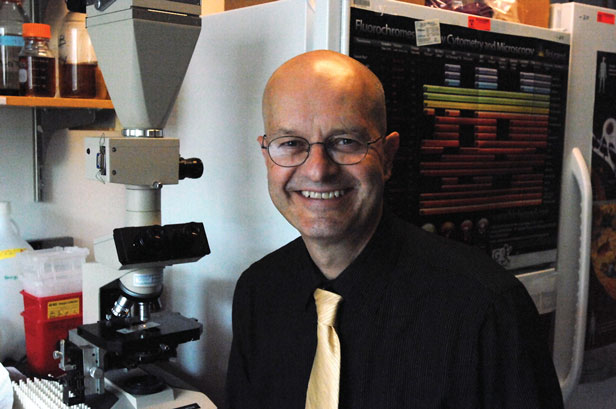The Downside of Sirtuins

Over the past decade, MIT biologist Leonard Guarente ‘74 and others have shown that very low-calorie diets provoke a comprehensive physiological response that promotes survival, all orchestrated by a set of proteins called sirtuins.
Now, Guarente and colleagues have shown that sirtuins are also likely to play a key role in the psychological response to dietary restriction. When sirtuins are elevated in the brain, as occurs when food intake is cut, serotonin levels drop in mice and the animals become much more anxious. Furthermore, in two large genetic studies of humans, the team found that mutations that boost production of sirtuins are commonly associated with higher rates of anxiety and panic disorder.
The researchers believe this anxiety may be an evolutionary adaptation that makes animals—including humans—more cautious under the stress of having to forage more widely for scarce food.
“It makes sense, because behavioral effects would be as adaptive, and as selected by evolution, as physiological effects,” says Guarente, a professor of biology. “I don’t think it’s surprising that behavior really falls under the umbrella of natural selection.”
Guarente discovered about 20 years ago that sirtuins prolong life span in yeast; since then, they have been shown to have similar effects in worms, mice, and other animals. Normally turned on in response to stresses such as starvation or inflammation, the compounds coördinate a variety of hormonal networks, regulatory proteins, and genes, with a net effect of keeping cells alive and healthy.
His new research, published online in Cell in December, examined mice with elevated levels of the SIRT1 protein in their brains and mice with no SIRT1. Researchers placed them on a circular raised platform with two quadrants protected by a wall and two unprotected quadrants. “Normal mice will spend a considerable amount of time venturing out into the unprotected region, and super-anxious mice tend to stay in the protected area,” Guarente says.
The mice with very high sirtuin levels spent much more time closer to the walls, suggesting that they were more anxious. Mice lacking sirtuin were much more adventuresome.
The team investigated the cellular mechanism behind this phenomenon. They found that sirtuins help control levels of the neurotransmitter serotonin, long known to be critical for mood regulation.
The new research suggests that anxiety could be treated with drugs that inhibit sirtuins. But it also offers reason for caution when treating patients with drugs that activate sirtuins, several of which are now in clinical trials for diabetes and other metabolic diseases. Those drugs can’t enter the brain, but some researchers are exploring the possibility of using sirtuin activators to treat neurological disorders such as Alzheimer’s disease. If such drugs were developed and approved, doctors might need to watch for anxiety as a possible side effect.
“We want to learn as much as we can about the biology of sirtuins, to inform the use of sirtuin drugs to treat diseases,” Guarente says. “The more we know about the biology, the better position we’ll be in to know how to use the drugs, how to dose them, and how to anticipate any possible side effects.”
Keep Reading
Most Popular
Large language models can do jaw-dropping things. But nobody knows exactly why.
And that's a problem. Figuring it out is one of the biggest scientific puzzles of our time and a crucial step towards controlling more powerful future models.
The problem with plug-in hybrids? Their drivers.
Plug-in hybrids are often sold as a transition to EVs, but new data from Europe shows we’re still underestimating the emissions they produce.
Google DeepMind’s new generative model makes Super Mario–like games from scratch
Genie learns how to control games by watching hours and hours of video. It could help train next-gen robots too.
How scientists traced a mysterious covid case back to six toilets
When wastewater surveillance turns into a hunt for a single infected individual, the ethics get tricky.
Stay connected
Get the latest updates from
MIT Technology Review
Discover special offers, top stories, upcoming events, and more.